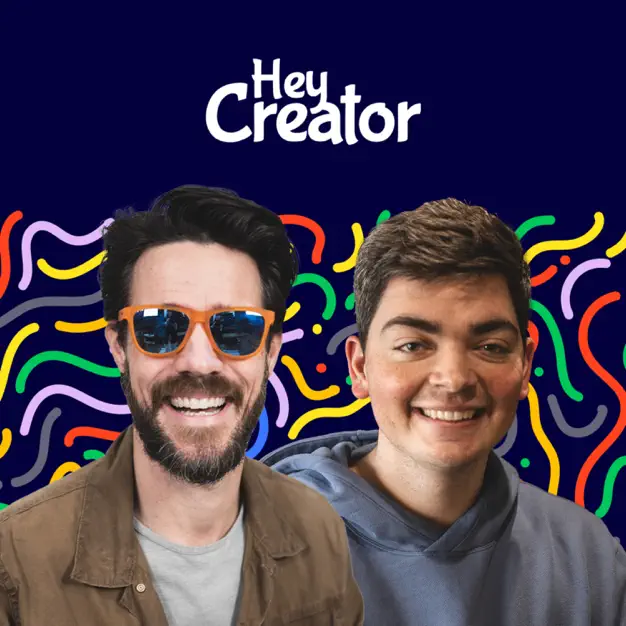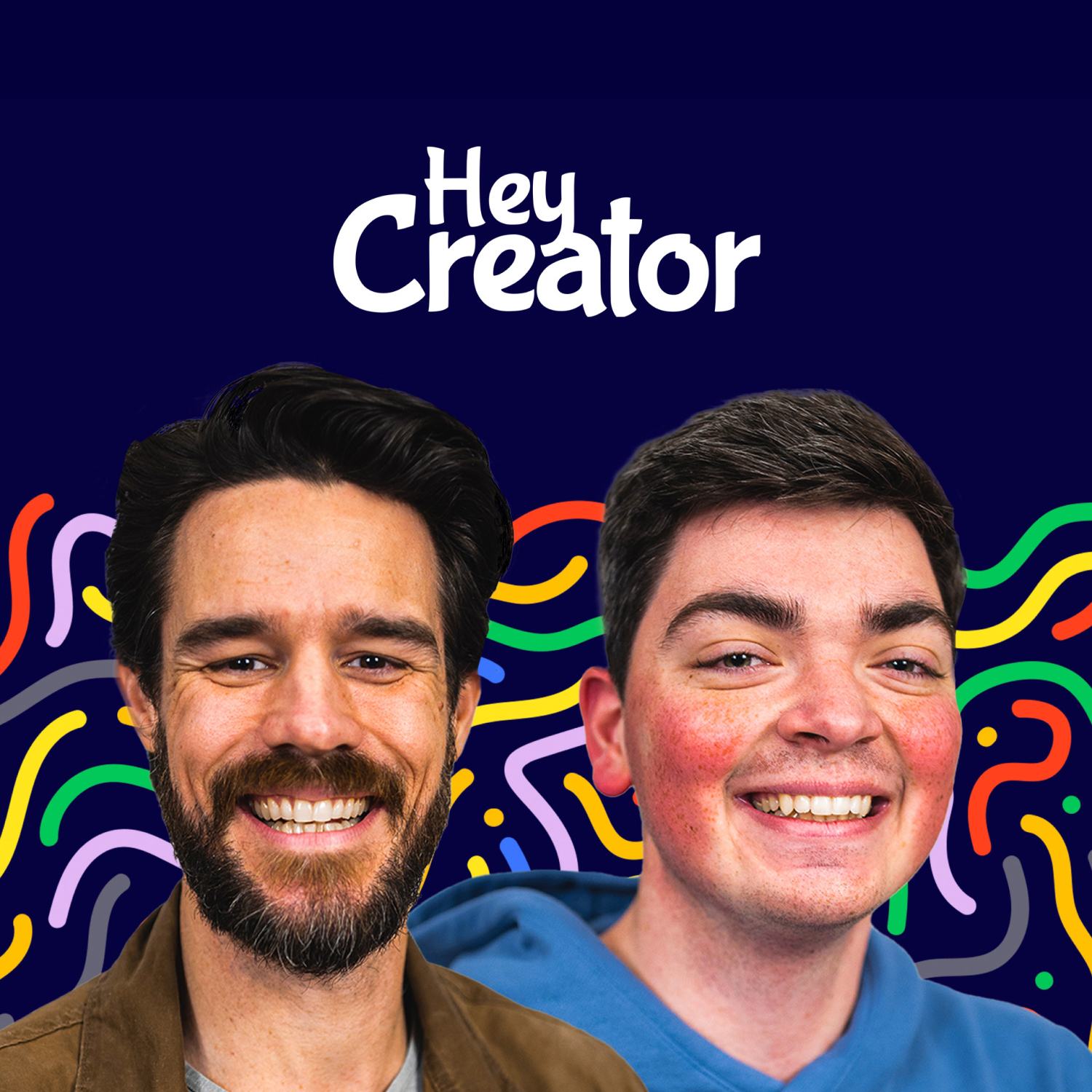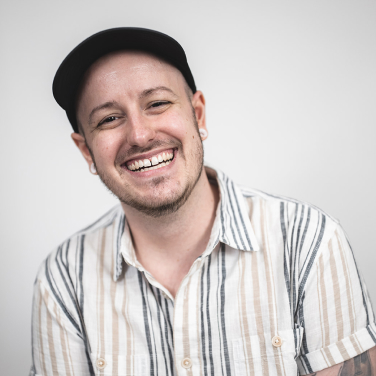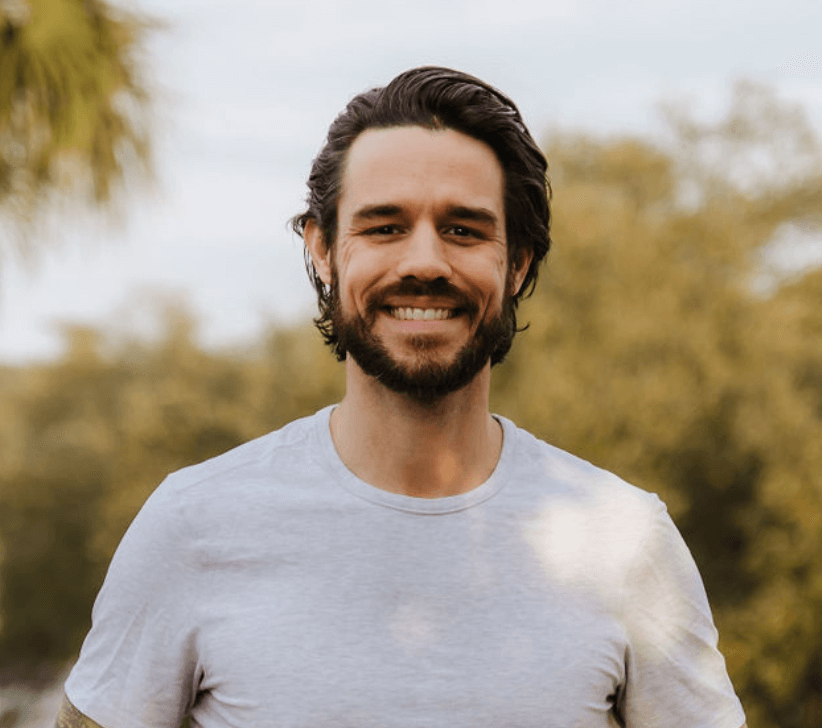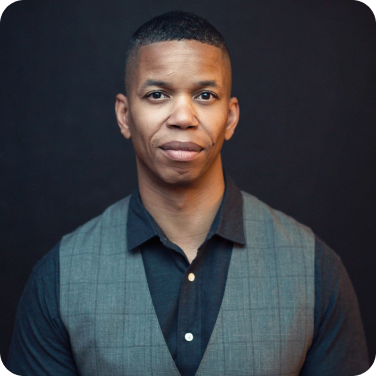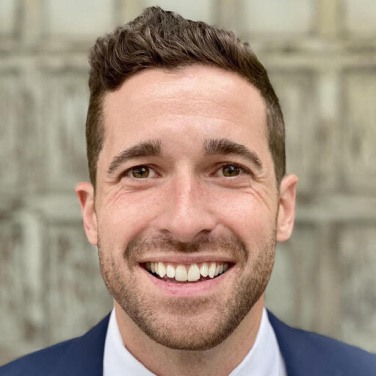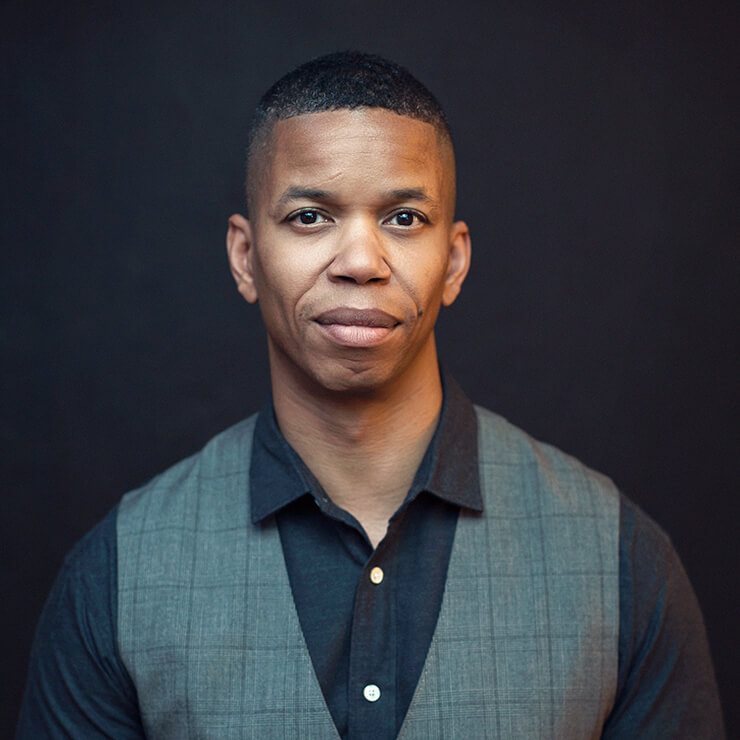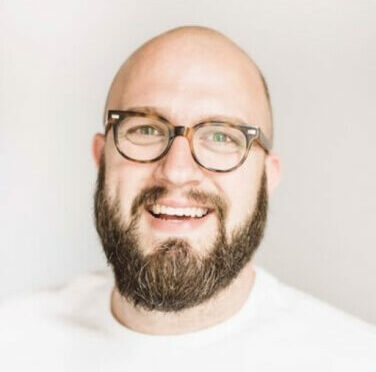[00:00:00] Matt Ragland: HeyCreators, I want to tell you about the sponsor of today’s show and it is Riverside FM. Now I love using Riverside for the HeyCreator podcast, but we use it at HeyCreator for many other things, including client interviews and community calls at times. It is the best tool that I have found. found for recording podcast episodes, either by myself here with Tim or with our guests.
[00:00:27] There are several reasons that we chose Riverside to be the tool of choice for the HeyCreator podcast, but let me give you a few of my favorites. The very first one is the ease of use and the quality of the audio. All I have to do is send a link to the guest and they can join. There’s no additional software for them to download or anything special for them to do.
[00:00:47] It is so easy. The other big thing that I love about Riverside is how it records all of the audio and video locally and individually per guest. What that means is if someone drops a connection, it doesn’t affect anyone else’s feed. It also means that if someone has some background noise going on or something that could affect other people on other recording platforms.
[00:01:10] Riverside isolates all of those tracks, which makes it really easy to clean up in post production. Another great feature that Riverside has come out with recently is their AI clip generator. This makes it so much faster and easier to get those short form, vertical videos from the best moments of The Hater.
[00:01:27] I highly recommend using Riverside FM for your podcast. And to get a special rate, all you have to do is go to riverside. fm and use the coupon code. HeyCreator. That’s one word. HeyCreator for 15 percent off any Riverside plan.
[00:01:46] Welcome to the HeyCreator podcast. I’m your host, Matt Ragland. And today my cohost, Tim and I talk about our Mount Rushmore of specific content that has inspired us. So in episode one, we talked about the people and there is going to be some overlap here because the people that inspire you tend to create specific pieces of content that inspire you.
[00:02:04] But we’re going to get a little bit more in the weeds and talk about why specific. Let us down the path that we’re on now. Before we get into our most inspirational content, Tim and I are going to talk about a couple of ways that that creators commonly overthink their work. And the most common way that creators struggle and overthink things is by Having trouble settling and picking one particular focus or niche for their content.
[00:02:41] This question of how creative. Creators commonly overthink the biggest way that I often see this, and I know I’ve faced it in my own creator journey is trying to decide which topic or niche you need to focus on. If you need to focus on one at all, and this is something that I commonly see creators struggle with, have a hard time with, especially if there’s this like dangerous element of you have three or four things that are all working.
[00:03:09] pretty well, but you feel like maybe there’s something specific that I need to focus on. So I asked Darrell Vesterfeldt this on a recent HeyCreator, Founder Friday community call, and I was really inspired and informed by the way that he answered it because he said, He brought up a question that I don’t think often enough about when I’m making decisions like this, and I thought it brought a lot of clarity.
[00:03:33] So let’s go to this clip from Darrell, because I think it’s really going to inform the way that you think about this decision.
[00:03:39] Darrell Vesterfelt: The answer immediately is it depends. One thing that I care very, very deeply about is like, what is the goal that we’re trying to accomplish? Cause there’s a different answer for every type of goal that somebody might have.
[00:03:50] Like. Hey, if the goal is I’m trying to create a little bit of side hustle, I think you should write about whatever you want to write about and have 14 niches and you should just have fun and enjoy it. If that’s the ultimate objective, the question here is like, what is the ultimate objective? What are you trying to accomplish?
[00:04:07] I think nine times out of 10, people don’t get where they want to go because they don’t actually know very clearly where they’re trying to go. Second is I think. A lot of times people end up at wrong destinations because they weren’t clear about what the objective was from the start. That’s happened to me so many times where I’ll like put my head down and I’m running really fast and I’ll wake up.
[00:04:26] I’m like, I don’t even like this. Why am I still here? And so getting really clear on objectives is number, number, number, number one. For example, with the school of traditional skills, before we even raised a single dollar before we had a single. minute of recorded content before we even incorporate it as a business.
[00:04:43] We knew what we were trying to accomplish. We knew what the end looked like. How clearly can you tell me the end? What is it that you’re trying to get to? How clearly can you tell me that? Like, don’t tell me that you want to make 10 million someday just because it’s some big number that you heard someday.
[00:04:55] I think a lot of people create. Ideas or objectives in their minds that are other people’s objectives that they’re just trying to copy, or they think they should tell me why you want to make 10 million a year. I know why I want to, but it’s also okay. If you want to make 250, 000 a year, because that’s like, that would create a lifestyle for you.
[00:05:14] That would make you and your family happy to me. It’s like objective is number one. So it depends. It’s all about objective. That being said, let’s assume the objective is to create a business that sustains us With some kind of regularity where we’re not stressed about making money every month. Let’s assume that it’s kind of like maybe what more people are wanting.
[00:05:33] It’s like, Hey, I want to like have a life that gives me some freedom that I’m making money on a consistent basis. And I don’t have to worry about making money. You’ve got to pick one niche. Doesn’t mean you have to talk about one thing, but you have to pick a niche more specifically than picking a niche is you have to create.
[00:05:48] A customer avatar that needs what you have to offer. So to me, there’s like a little bit of a quadrant here. You have to find a problem that needs to be solved. Let’s find a problem. The scale of that problem will determine the scale at which people will pay for it. That problem has to be something that you have some level of competency solving.
[00:06:07] And if you don’t have any competency in solving that problem, you’re going to always feel like a fraud a little bit. So that’s why it’s like, you’ve got to have some level of competency in solving that, because this is where a lot of imposter syndrome comes in. It’s people like see an opportunity and they’re like, I’m gonna go solve that problem for that person, but they don’t actually know how very well.
[00:06:23] And so like imposter syndrome comes up. So it’s like problem that I know how to solve that people are aware of. So this is another problem that I see often happen is that people solve problems that the people aren’t actually aware of. And so a good example of this is like trying to talk people into losing weight who don’t actually want to lose weight.
[00:06:41] So your avatar is not somebody who’s sitting on the couch watching Netflix eating Burger King. That’s not the avatar because that person still wants to be eating Burger King. Your avatar, if you’re a fitness, your avatar is somebody who maybe has a gym membership and showed up three times but doesn’t know what to do next.
[00:06:55] So it’s like getting really clear about the avatar. It’s like making sure they’re aware of their problem. A lot of times people are like, oh, I’ll just teach them. I’ll just like help them become aware. And it’s like, well, then you’re spending all of your money trying to talk somebody into solving a problem that they don’t like super aware that they have.
[00:07:08] And then the fourth quadrant is that they’re willing and able to pay. Alex Ramos, he talks a lot about this and I love the way that he frames it. It’s like, if you solve 2 problems, you’re going to have 2 solutions. So like, is the solution to the problem that you’re solving, kind of making a full circle back to like the problem that you’re solving, is it something that people are willing and able to pay for?
[00:07:25] People may be willing to pay for it, but they’re unable because of. You know, your avatar is a 13 year old and your solution is a hundred dollars. Well, they just don’t have a hundred dollars. You’re gonna have to ask their mom and dad. So I’m, I’m kind of making very simplistic things. You kind of understand it, but to me, it’s like picking a niche is actually just picking an avatar and a problem.
[00:07:42] And that’s the niche. Right? So what happens a lot of times is if you, if you have too many things that you’re talking about, you’re trying to talk to too many people about too many things. If people are confused about how you can help them solve a problem, they’re going to go to somebody who is very clear how they can solve the problem.
[00:07:58] Matt Ragland: That question from Darrell of making sure that you understand the goal or objective of the content that you want to be creating and of the business that you want to be building Was really informative for me because he, he alluded to a conversation that he and I had that we didn’t get back around to talking about on the call when we were talking about, Hey, like how much, how much money do you want to earn?
[00:08:22] What is like your goal? And I just threw out a big number without really thinking. I was like, ah, I’d like to make 200, 000. And. And he was like, okay, why? And I was like, because of like this house and this car and this amount of security that it would give my family. He’s like, do you know how much those things cost?
[00:08:38] And I was like, yes, I know how much those things cost. He’s like, well, maybe you could need less. Than 200 K. That was a really big unlock for me and like I’ve had this conversation with Darrell multiple times, but when it comes to overthinking and selecting like a specific niche, there’s a lot of things that you can think about.
[00:08:58] But understanding what the goal and what the objective of your business or of your content is, is really clarifying and something that I encourage everyone to think deeply about. Okay. I wanna go ahead and bring in my co-host, Tim. Hey Tim. How’s it going? Let’s go. I’m here. Let’s do it. Let’s go. Let’s go.
[00:09:16] All right. The thing that Darrell and I just talked about, I know you and I have had some discussions about those topics as well. So we also have like this bigger, bigger thing that we’re talking about of ways that creators overthink and often get in their own way. They get in their own head. It’s a struggle, but let’s like start with picking a niche, with defining a brand or a business.
[00:09:39] For yourself, what has your experience been with that? And like some of the struggles that you might’ve faced.
[00:09:44] Tim Forkin: So I mentioned this in the earlier episode, I have started so many different things, so many different niches. I’ve talked about sports, music, content, creation, video editing. If I had my way, I would be talking about all of those things and doing all those things, but that’s just not realistic.
[00:09:59] I like. On my road to greatness have found that this content world, this creative business and everything like this is like where I can do, um, the most it’s where I have the most impact. And I’m reminded of the Japanese concept, Ikigai, which means a reason for being. So the topics that you talk about in the business you build should be intersection of what you’re good at, what you love to do.
[00:10:24] Or you can be paid for and what the world needs. So last year, a little bit more backstory. This was short form video editing for me. This was a skill that I had that I liked doing, that I was actually paid more handsomely than I thought I would be paid for. And clients came to me like they, they needed it.
[00:10:41] Right. And this year it’s building HeyCreator. This is so fun. I think we’re doing an awesome job in the early stages here. This is part of my career now, so I’m being paid for it. And this is what the world needs. They need to hear these conversations from you and I, and people in our creator universe who can help put them on a better path as they become creators and build their businesses.
[00:11:02] So there’s a lot there, but. What you’re good at, what you love to do, what you’ll be paid for and what the world needs. I don’t know what else you might need there.
[00:11:10] Matt Ragland: Yeah. It’s the convergence of those things. And Chris Gillibeau talked about this like 10, 10 plus years ago. It’s kind of like putting a Venn diagram together of, of those elements and making sure that there is an overlap.
[00:11:22] There is a convergence of those things and that’s where you’re going to find, that’s where you’re going to find your business. The key thing that Darrell was talking about and Tim alluded to as well is that the more specific you can get about who that is for and how you can help them, that will define the business that you, you can do some research and just have some basic understanding of those customer avatars and the needs that they have in order to better discover like how, how deep that needs to go.
[00:11:54] One of the examples that Darrell and I talked about on that clip was me going from, uh, going from general life advice on my YouTube channel to productivity advice, further down to the bullet journal, and even further down into like specific bullet journal, like minimalist bullet journaling. So not a lot of arts and crafts on the bullet journal as you might often see, but it’s like, Hey, all you need is a pen and paper.
[00:12:20] And, uh, maybe a ruler to make sure that you get those lines nice and crisp. But it, you don’t need a bunch of colored, you don’t need a bunch of colored pens. And so like going all the way down, like that’s four levels down on the niche, but it was through like. Making sure that I was focusing on these things that it became clearer and clearer to me what the conversions of those elements were.
[00:12:40] Tim Forkin: Yeah, and that takes us right into our next point. Like, you have to think long and hard about which piece of that you want to dive all the way deep into, right? You, like, how long did it take for you to figure out minimalist bullet journal is what I want to be talking about?
[00:12:58] Matt Ragland: It honestly only took a few weeks for that specific, like, next level down on the niche, but it took me 11 months of content on YouTube, over 60 videos, to go like all the way down those levels.
[00:13:13] And it was because I was consistent in those things, and I guess that’s one of the other like, kind of like, maybe caveats to this is, you can often find the overlap of the things that you want to talk about by maybe talking about more things early on just to see what resonates with you, things that you enjoy, like you were saying, so that that you enjoy doing and what people are interested in.
[00:13:36] The, the challenge and I, where, where I believe that creators continue to overthink this and get in their own way is if you’ve done months, if not years of multiple topics and still kind of struggle to decide like, all right, well, I’m just going to talk about bullet journaling, or I’m just going to talk about productivity.
[00:13:55] You got to go all the way on one of these topics. In order to can think about putting your flag in the ground. You can’t like put, it’s the difference between like putting a stop sign and putting like a road direction sign. Like I could go, I could go here. I could go there. You could go that way. You could go back the other way for instead of just saying like, Hey, this is what I do, and this is where it’s going to take you.
[00:14:17] Tim Forkin: I love that. I love that. We should keep going because I know I overthought that so much like I wanted to be a sports creator. I wanted to talk about music. I wanted to do be like a video, like actually teaching like videography and that that quickly wasn’t for me editing. And I wanted to be more broad than that.
[00:14:35] And then I would, I would keep sorting through it all and I would overthink it so much. And I think that’s among the most common ways that creators overthink.
[00:14:43] Matt Ragland: Yeah. Another one that just like. Always shoots up to me, especially like I’ve been working with creators, both as, as a leader, as a startup employee, as like a freelancer.
[00:14:54] And one of the things that continues to show up over and over again, time after time is. doing more than what is absolutely necessary to like start building momentum in your content. And a really common way of this is like, Hey, I want to start a creator business. So like the word, the worst part of this is like, you try and get like an official LLC or S core set up before you even write any kind of content.
[00:15:21] Like eventually you should probably have that, but. Don’t let that slow you down. Another one is like, Hey, I gotta have like this whole website set up and I gotta make sure that I have all the pages done and I have to make sure that I have my colors and my logo. Like these are some of you listening may think like, Oh, well, you didn’t, obviously you don’t need that.
[00:15:39] But I’m telling you, there are a lot, a lot of you listening who you’re either in that place right now, or you’re kind of like chuckling to yourself. Like, ah, yeah. If I only, if I only would have known, or maybe you’re about to start on that. Don’t, don’t worry about it. Like, honestly, right now, if you’re overthinking this, all I would do from a content perspective to start something up right now is start posting on your favorite social network, like, short clips or, like, tweets, texts, LinkedIn, X, any of that, and then set up a landing page to collect email addresses.
[00:16:11] That’s, I, there are, like, sub steps to that, but I’d say, like, start collecting. Start creating content on your favorite social media channel and set up a landing page to collect email addresses.
[00:16:23] Tim Forkin: This is the kind of conversation that I wish I would have known, because I can’t tell you how many Squarespace and Wix websites I made growing up.
[00:16:29] You don’t need to go through all those templates. Yeah. You don’t need, you don’t need that. You don’t need to be paying for all these different things either. That’s a, that’s a part of it. It’s like, you feel like you’re doing a lot because you’ve. paid for all the subscription services, you, you have a full tech stack, but you haven’t written or recorded a single thing.
[00:16:44] Matt Ragland: Yeah. It’s same thing with like with Notion, like, Oh, I want to use a tool like Notion, like, well, obviously I have to have my, like my whole Notion template set up my whole like content calendar, ready to go before I, before I start writing anything. And this goes back to what we were talking about at the very first episode, which is how do you know when you’re ready to start something?
[00:17:02] And it’s like, yeah, would it be nice? To have like a queue of content, a buffer of content ready to go before you start publishing. Yes. But if you set a goal, like you’re going to get this in early March, 2024, if you’re listening back to the archive, if you set like start a newsletter, start posting on social as your new year goal, and we’re a couple of months into the year, and you’re still billing out your content calendar instead of posting consistently, that’s That’s the way that you’re overthinking it.
[00:17:31] Tim Forkin: The thing that I think creators overthink the most at the very, very beginning, even before their tools and like all that is that they don’t want to create something that people will judge them for. They’re so worried about being like what the people in their immediate, like current life state will feel about what they do.
[00:17:49] I know when I started making YouTube videos again, when I was in college, it came from realization that like, Hey, I finally don’t care. I’m not obsessed with like my image in front of all these people. I went to high school with. Or that I’m in college with. Like, I can make these videos. It can be cool to me and people on the internet, and I don’t need the approval of these people in my life.
[00:18:07] And I mean, it’s a, it’s a, it’s a phrase as old as time, but like, nobody’s thinking about you more than you are. Nobody’s thinking about, oh, the way you look on camera in your first five videos. Like, sure, there might be people who like, are actually like bad and mean. And like, we’ll send it to their friends and maybe have a bad comment.
[00:18:24] But like, I think I saw JT Barnett post something about this. It’s like the content you make it are not for, it’s not for the people in the room with you when you decide you’re going to do this, it’s for the whole vast internet world. So my big thing is. And it’s, it starts even before, like you build the tech stack or you buy all the gear is like, you don’t want to start creating and you overthink your ability to create because you’re just so worried about what people think.
[00:18:51] Matt Ragland: Yeah, that is, that is a really common and insidious way that people can procrastinate and overthink. Uh, you mentioned another one that I commonly see, and it’s, a lot of these are related, but it’s buying too much gear. at the beginning of this. So especially if you’re in a more technical, uh, say more gear heavy world, like podcasting or video, and you’re like, well, I’ve got to get the like latest Sony or Canon camera.
[00:19:22] And I’ve got to get the latest road mic to be able to do this. Oh, you know, that’s 300, 500, 2, 000. And don’t forget about lights. And like, especially if you’re doing video. But. That, not only is it a little expensive, and you can, like, use that as a procrastination point, a way of overthinking. It’s like, oh, well, you know, I don’t have two grand to spend on gear right now.
[00:19:46] Guess I’ll just, guess I’ll just do it later, whenever I’ve saved up enough money.
[00:19:50] Tim Forkin: Yeah. I mean, if you’re watching on YouTube right now, or this is a clip that we post, like you can see, I don’t have anything on the walls. This is not like in my apartment. This is an office that I found near my apartment, right?
[00:20:01] This is the mic that I’ve had for a while. My lighting setup. I just found a desktop lamp in here and we’re doing this, right? This is, this is the early stages. Maybe I, maybe one day I will have this big thousand, 10, 000 setup where I just look like the biggest creators in the world. But that’s not going to stop us from, from spitting truths here and helping people, you know, like we’re doing this.
[00:20:20] So, and I don’t need, I don’t need the big setup to do that.
[00:20:23] Matt Ragland: No, yeah. The, the only thing, and you can do it, like, I know that you have thoughts on cameras and especially like, I think you do most of your, if not all of your like video work just on your iPhone right now.
[00:20:35] Tim Forkin: Right. The filming side. Yeah. Like I, I’m a big proponent of lowest period entry, so I don’t have my Sony anymore.
[00:20:42] Like I have my phone, my phone can do 4k. I have like the iPhone. I think, what are they on 15? I’m on like 13. And everything that I film for, for my short form stuff is on my iPhone. If you want to go down this for a second, like another way people overthink. Not having the right gear, lowest barrier to entry on editing, on filming, on, um, the way you write things.
[00:21:03] We kind of mentioned this in, in this episode, like you don’t need any of that at all. Like you just need the bare minimum. They’re your lowest barrier to entry. And for me, because I come from a more like technical video background, I edit my TikToks, which Is like the opposite of what you’re supposed to do.
[00:21:19] I edit them in Adobe premiere. It’s just the fastest for me, right? For most people it’s CapCut or not touching it at all.
[00:21:25] Matt Ragland: Yeah. And like Tik TOK and Instagram both have good editors for their reels. And so like, especially if you’re doing short form video, like shoot it on the phone, make light edits and then ship it.
[00:21:34] And then do another one tomorrow or do another one two days later. The only like caveat I would say, like, especially for a podcast, there are some, like, I would actually say that I think podcasting is the most like technical, because if you don’t sound good on your podcast, then that is like, that is a way that people wouldn’t take you as seriously.
[00:21:53] I’m just going to say, but that being said, you can get solid, good sounding. USB microphones off Amazon for less than a hundred bucks. I definitely wouldn’t just like talk at your, uh, like computer for a microphone if you’re going to be doing podcasting, but same thing, like, don’t overthink it to me, like I gotta have a soundboard and I gotta have a like preamp and I gotta make sure I get XLR cables and I gotta have like.
[00:22:21] 200 headphones that I can listen in on my 500 mic. You don’t need all of those things. There is, there is a barrier to entry for some of this, but look for the lowest high, the lowest quality barrier that you can hit.
[00:22:35] Tim Forkin: I love all that. I have a, I have a few more like smaller ones. Yeah, let’s go for it. I think, I think that like that one is great.
[00:22:40] Lowest barrier to entry. Um, one thing I want to, I want to ask you about this. I had this down. It might just be like something I overthought. But I want to know if this is like a common thing or if you felt this but Thinking about the business side of it too soon. It’s very obvious when you come across someone who’s only creating content to make money, they only are pitching you.
[00:23:01] They’re trying to get you on like some, I made a video about this, like this 18 year old guy trying to get you on like a high ticket
[00:23:09] Matt Ragland: coaching program. Like be like, would I be.
[00:23:11] Would I be driving this whip if I wasn’t, didn’t know what I was talking about? Yeah, exactly. It’s like I,
[00:23:17] Tim Forkin: I just graduated high school and I can help you make 20k a month.
[00:23:20] It’s like, who is your dad? Like who, who are your parents? Who’s your daddy? Yeah. Yeah. Uh, so I know that I’ve like, oh, I want to, I have this business idea. So I’m gonna start creating content around it. And that content at first is like very salesy. It’s, it’s very obvious that like I’m trying to get the person on the other side of the screen to like Sign up and pay me and I think you can like really hurt the business or the thing you’re trying to build by doing that When you approach
[00:23:50] Matt Ragland: it that way it definitely hurts your authority it hurts your personal brand and it just hurts the Influence that you have in the way that the way that people see you now I will say that once you’ve done this, so always, always lead with value, always lead with value, and you’ll probably have to lead with value long enough to build enough of an audience that you start to like insert your offer or your service to like truly demonstrate, hey, I’ve already shown you for the past like three months, the past year.
[00:24:24] that I know what I’m talking about with this. Here are some ways that we can work together. I think Justin Welch does this as, as well as anybody. Because you’ve spent so much time demonstrating expertise and showing the value that, that you have. Darrell talked about this in another, uh, Founder Friday call recently.
[00:24:42] When you give so much value, like our example with the HeyCreator Summit, five days, 20 sessions, like so like way more than any online summit normally does and. Then when we opened it up to the community, we had like, we doubled, we doubled our goal for a number of people that we wanted to sign up. Now here’s, here’s one little distinction on it.
[00:25:03] Once you’ve done this and you’ve started to make a name for yourself and people trust you and you’ve delivered on that value time after time, after time, after time, if you have another business or another service at this point that you want to start, you can start selling it literally from day one because the people who are following you, they’re like, Oh, I trust Matt.
[00:25:21] So they’re transferring that trust they have of me into another thing that I’m doing. So that is one way of looking at it is like when you’re pretty early on, you have to like do so much to establish your reputation. Gosh, that was a word I was looking for you to establish your reputation and show your expertise and deliver value.
[00:25:42] But once you’ve done that, and I feel like I, like I’m in a, like, I’m in a phase of that right now that if I say I’m starting something, there’s like trust that has been transferred to that thing that I’m doing and people know that I’m going to deliver on it.
[00:25:55] Tim Forkin: Yeah. And secondhand, because I’m on this show with you, I feel like people are going to trust me because I’m associated with you.
[00:26:01] Like this is a huge boost for me. There’s,
[00:26:03] Matt Ragland: yeah, there’s, there’s some of that. You’re welcome. Yeah. A lot of what I built from an email marketing perspective was from the three, four years, from the four years, almost that I was at ConvertKit and I was pretty public, uh, as a part of that team. I ran all the workshops I did.
[00:26:18] I did a lot. I worked in account management. So when I started doing other things and you’re like, Oh, well, one of the things I started with was helping people with their email marketing and automation. So when I went to people and said like, Hey, I worked at ConvertKit and here’s a bunch of, here are the help articles that I wrote and here are the videos that I did and here are the workshops.
[00:26:33] I was like, Oh yeah, this guy knows
[00:26:35] Tim Forkin: what he’s talking about. Here’s my money. To circle it back to the overthinking part. It’s really easy to overthink if you’re not actually an expert or if you haven’t provided value for a long enough time, you can, you overthink everything because you’re, you have imposter syndrome.
[00:26:48] And I think all of us have imposter syndrome to some extent. It goes away maybe in spurts, but I don’t think it ever fully leaves. And. I think like fighting with that as a way to overthink a few more, uh, smaller ones, underestimating your audience size, a hundred views or likes or followers. It doesn’t seem like much at all, but if you or I like had to speak to a hundred people in about five minutes, we would freak out.
[00:27:12] I’ve had this, I’ve had
[00:27:13] Matt Ragland: this same, I’ve had the same thought. I wouldn’t freak out anymore, but like if it was a thousand people, maybe, or 10, 000 people, but you’re right. Like that is, When you put it in that context that use the number of people that liked your thing, or maybe that follow you. And if you had to go give a presentation to them in the next 15 minutes about like something that your expertise thing, then that would be pretty anxiety inducing because I could say like, you know, this is going to sound like a humble brag, but I have almost a hundred thousand YouTube subscribers.
[00:27:44] That’s bigger. Than any NFL stadium. It’s as big as any college football. STA Stadium, not the big house. Shout out to shout out to Michigan who I like, kind, kind of hate, kind of hate as a Gator fan. Sad times for me, but. If I had to go give a talk at, you know, Ben Hill Griffin Stadium, at the Swamp, at the Big House, then that would be, that would be pretty stressful.
[00:28:06] Pretty stressful, not gonna lie. But those, that number of people has said like, Hey, yeah, I wanna, I wanna see your YouTube content. That’s,
[00:28:13] Tim Forkin: that’s crazy. I have one last thing, uh, it kind of connects everything, uh, we’ve talked about on camera specifically. And I think this, this goes into other things, but specifically on camera, I want everyone to know that this podcast is edited, right?
[00:28:25] We are making mistakes as we’re recording this. I used to beat myself up so much for not getting the words, right. I would have to edit them so, so much. Cause like I dreaded recording. I had this for a long time, longer than I probably would care to admit. And I like, Matt you’re one of the first people that I edited and I realized that you were like making as many if not more Mistakes and you had probably more 60, 000 YouTube subscribers when I just
[00:28:53] Matt Ragland: be cussing at myself and yeah, you know off camera.
[00:28:56] Yeah, I
[00:28:57] Tim Forkin: Know exactly how it feels to be that person who it just can’t get the words, right? Maybe you’ve you’ve written a script or you just can’t like wrap your mind around the idea to say it And that was a big realization for me. I want everyone to know that this podcast is edited I after recording this we’ll we’ll go dissect it and cut out the parts where we messed up You hopefully will never hear them And if you do, you know, like it’s my fault, but it’s a mistake.
[00:29:22] You’re going to make mistakes Like you are going to mess up in recording in your business. If you want to get more broad here, you’re not always going to make the best decision. Everything that we’re doing. We feel like it’s the best decision right now for what we’re doing on camera or off. You, I know that I was the person I’ll say it one more time, red faced and frustrated in front of a red light on a camera in my room by myself, hating all of it, hating that I had this desire to do it because it made me so frustrated.
[00:29:49] But. That’s like another big thing for me is that I know I can feel it for you or anyone who is overthinking When they got to hit record and when they want to go into video In general, I know that’s like a big, big barrier. You have to jump over to actually do this.
[00:30:07] Matt Ragland: Man, if I could capture that, I mean, we are capturing this through the podcast, but one of the things that I want to call out for everyone, just as we, we wrap up this, this segment is if you want to be part of conversations like this, that’s what the hate creator community is for.
[00:30:20] We’re talking about how you have those moments that you have those frustrations. And I can tell you, I said, I already talked about that. The size audience that I have. And it’s great, but I still like, I’ll be recording ads here. We’ll be in the middle of a segment and I’ll just be like, you know. I like very, very frustrated at myself and I’ll record a YouTube video later and I’ll do the same stuff and talking about that in a community around a group of people that get it and they’re like, Oh, I do that.
[00:30:49] I do that too. Because what you said, Tim, like I was in. You know sitting in a room by myself trying to get this right and having like no one who understood What I was going through and no one that could maybe encourage me or say like, oh we all do that Maybe to do it better next time and you you actually gave me this feedback earlier today It’s like hey, just try and say less each time and then we’ll we’ll put it all together in post production So don’t try and say all 50 seconds of the ad read at once.
[00:31:18] Don’t try and memorize it. Just go like five seconds at a time. So if you want to be around people who will give you that kind of support and encouragement and like very literal, helpful advice on how to make it better, you should check out, Hey, creator community, go to Hey, creator. com slash community and check it out for your first month.
[00:31:38] HeyCreator. I have a secret weapon that I want to tell you about. First I want to tell you how I use it. You know those awesome HeyCreator newsletters that go out once or twice per week that sign off from me, Matt Raglandd? Well, I’m not writing those, not directly anyway, because every newsletter is researched, written, edited, and uploaded to ConvertKit by our automatic evergreen team at HeyCreator.
[00:32:07] And the reason those newsletters sound like they’re coming from me is because they’re coming directly from the HeyCreator show along with special presentations that I’ve made in the community, keynote speeches or other podcasts that I’ve been a guest on. Automatic Evergreen lets me send high converting quality newsletters on time every week with a fraction of the time and attention that I used to give to a newsletter.
[00:32:27] And this is so valuable because it gives me more time to focus on the podcast and on the community. Thank you. If you’re curious about how Automatic Evergreen can put your newsletter on autopilot and make you money, then click the link in the show notes to book a call.
[00:32:45] 25th birthday, October 9th, 2008. Happy birthday, Matt. We’re blessed to be your parents. Mom and dad gave me Tribes by Seth Godin. This was my second or third. Seth Godin book. It’s definitely the one that has become the most, uh, impactful for me of Seth’s work. And the most prescient, I think. I mean, Seth wrote about a lot of things that have either become even more true than they were at the time, or become true in how the internet has developed.
[00:33:22] And I think that Tribes, which came out in Came out in 2008. My dad, Chuck, shout out to Chuck Raglandd, bought all of Seth’s books right when they came out. And got me, got me a copy. I think this came out in 2008. So this is one of a few books that we’re going to talk about today. We last talked about the Mount Rushmore, our like top list of four creators who influenced us at the beginning and along the way of our creator journey.
[00:34:02] And today we’re going to get. Even more specific and saying what pieces of content inspired you to do the kind of work that you’re doing, think about work, and being creative on the internet, specifically. In a way that has going to driven, driven your career. So as y’all are listening to this, I want to encourage you start to make a list.
[00:34:29] Even if it’s just like a mental running list, take out your notepad, take out your Apple notes, whatever you do, whatever you use to jot things down and start to just like capture a bullet list of things, but that’s what we’re going to be talking about today. I’ll share a little bit more about tribes, but Tim,
[00:34:46] Tim Forkin: if we’re doing this Mount Rushmore.
[00:34:48] Framing of it. It’s very fun to parse down and figure out exactly what, like the four things that are worth talking about, the four most impactful things that’s been a fun exercise for me. And like Matt said, I encourage you, whoever’s listening to make a list of your own, doesn’t have to be the four, but
[00:35:04] Matt Ragland: yeah, and I have to, I have to admit right from the jump that I totally cheated on this list.
[00:35:11] I have more than four. And I’m going to talk about more than four. So even the, did you, do you only have four? Did you pit, did you follow the rules?
[00:35:22] Tim Forkin: I have four main ones. I can quickly add more. Um, so if you want to keep going after four, we can do that. And I think we can probably take this one a little bit faster than we did with like the, the big creators.
[00:35:32] Matt Ragland: Yeah, I think that was another thing. That we were talking about after the last show is like having a little bit better pace on, on some of these lists, because, uh, some of these can be more rapid fire. I know there’s like, yeah, the, the like quick hitter questions, the rapid fire session to, to take it from the Tim Ferris show and a bunch of other like similar, uh, similar formats that have come out in the past.
[00:35:56] So. I’ve already started. I’ve started with tribes. Let’s go ahead. And that’s just going to be my first one. I don’t really have anything else to add to it. I also mentioned it in the last show, so y’all can go check that out, but it’s just, it’s just as applicable now as it was, I guess this is the 15th anniversary of tribes this year.
[00:36:16] No, that would have been last year. It’s 2024. That’s right. That’s right. That’s what happens when you get older, Tim. You’re like, what year is it? I know it’s mid February. Anyway, so it’s been out a while and it’s still just as applicable and relevant as it was in 2008. So that’s. That’s my, not my number one, I would say, like all of these, I, I, I don’t know if I could rank all of them, but it’s too hard.
[00:36:39] It’s too hard to rank
[00:36:40] Tim Forkin: them. Yeah,
[00:36:40] Matt Ragland: it’s, uh, it is. It’s like, it’s like, which kid do you like the best? So, uh, it’s too hard, too hard to rank. It’s a day by day scale. So, uh, uh, My first one that I mentioned is tribe Seth Godin. What do you got?
[00:36:54] Tim Forkin: In the last episode, I, uh, waxed poetic on Chris Do, what he meant to me, what he still means to me, like the, the start of my creator journey.
[00:37:02] And I mentioned his video about pricing. So the basis of it is just stop charging hourly. Stop pricing hourly. And when I was doing creative work, uh, when I started my videography business, pricing was the number one thing I had no clue about. Uh, I heard, and especially like for big scale production companies, hourly rate, day rate standards like that.
[00:37:22] Um, but the basis of the video is. By charging hourly for creative work, you’re punishing yourself for being good and efficient at what you do. There’s stories of, I don’t have the lady’s name in front of me, but she drew the Citibank logo. On a napkin and was paid millions of dollars for that. I’m sure there’s, there’s a logo story with like the Nike logo as well.
[00:37:45] Um, never put yourself in a position where you’ll be punished for being good and efficient, your creative work. As soon as I figured that out, I was like, okay, we’re never charging hourly for any, really any creative work. At least that that’s my core tenant. And it’s a core tenant of how I think about my life as well.
[00:37:59] Find ways to do my great work fast. So you can do as much or as little as you want. If you’re in a season of hard work, you can put your head down and do as much work as possible. So you can make as much as possible. Or if you’re in a slower season, you only have to spend a couple hours a day to make the living that you want to make.
[00:38:14] Um, so stop charging hourly, all of his stuff about the value based pricing, uh, from Christel that I will forever hold on to his messaging on that.
[00:38:24] Matt Ragland: I’m going to do in, in the spirit of cheating, I’m going to combine a couple of things to feel to make myself feel like I’m getting divorced. Divorce I’ve meant.
[00:38:33] I’ve mentioned tribes. So I’m going to have like a little book category. The other two books for me that made a real difference in my creative journey and my creator path. These are pretty, these are pretty popular yet. Like this, this is my list and they’ve been important to me. I encourage you to make your own list about what’s important to you.
[00:38:52] Uh, is those two books are The War of Art by Steven Pressfield. That was on my list. Oh, we’ve got, yes, we finally have some crossover. It Thunderbolts. Yeah, that’s right. Uh, the War of Art from Steven Pressfield and then Steal Like an Artist by Austin Kleon. Those two books. Actually, let’s talk about Steal Like an Artist for a moment, and then we can share a conversation about The War of Art.
[00:39:17] Steal Like an Artist. Was incredible for me and Austin has like this whole like little short series This other one is keep going. He has another book called show your work. So there’s still like an artist show your work. Keep going it’s kind of like a trilogy of these pretty short books and Not only are they good writing and very helpful and inspirational.
[00:39:44] I love the way, what was also inspiring to me, even more so than the content of the books themselves, are the way that Austin, uh, creates his books. They have a lot of, like, sketches and handwriting in them. They have a bunch of like things that I’m, for those of you that are like watching, watching the clips or watching the YouTube video, he does a lot of drawing to make his point.
[00:40:14] In these books. And so they make, he makes them interesting. He makes them engaging. I can remember like the graphics as much as I would remember the words. And so steal like an artist, really that whole like little like pocket book trilogy from Austin. That is a big one for me. I don’t remember when steal like an artist came out, but it was, it was a game changer.
[00:40:34] Tim Forkin: Let’s go into war of art. I have my story of how I found it. Uh, I love that it’s on both of our lists. Um, I, this is another one. I did not think that we would have the same list. I don’t think you and I have ever talked about the War of Arts. We haven’t, so that’s,
[00:40:46] Matt Ragland: that’s quite, that’s, that’s a big boost for this book, because we haven’t discussed it.
[00:40:51] Tim Forkin: And my story with it is, shortly after meeting, uh, Darrell Westerfeldt, founder of HeyCreator, he sent me this book. I don’t remember if it was unprompted or not. It might’ve, I might’ve been struggling with something and he just sent me a copy of this book. It instantly topped my Pantheon of important content.
[00:41:08] On the Pantheon. That’s another,
[00:41:09] Matt Ragland: that’s another good frame we got to think about.
[00:41:11] Tim Forkin: You can leave this in. That’s just the Pantheon.
[00:41:12] Matt Ragland: Yeah. The
[00:41:15] Tim Forkin: Hall of Fame, Pantheon, things like that. Well, we’ll, we’ll be doing many. Many creator Pantheon style things, but the first third of the book where he explains resistance and how it shows up in our everyday lives just shook my entire world.
[00:41:29] And that section of the book is. It’s turned to the book from a book that you read and like get stuff out of. It’s more of a tool for me It’s it’s something that I go back to or at least need to go back to every three six months as a tool to like recenter and Get better at what I’m doing to to fend off poor habits Resistance and becoming a pro are two key frameworks, like mindset shifts that I took from that and that I will always go back to.
[00:42:01] Prepping for this episode, I realized that I, that now is the time that I need to actually pick that book up.
[00:42:06] Matt Ragland: Yeah, it’s, it’s an all timer because again, the three books that I mentioned, Tribes, War of Art, Steal Like an Artist, they’re all pretty short, all under 200 pages, and not only are they short, they’re also like small.
[00:42:21] They’re like, Steel Like an Artist is too chunky, uh, it’s too square to fit in a pocket, but it’s kind of like that size. They are, I bet their word count is like 30, 40, 000 words maybe, and that’s, that’s pretty short as books go, and so they’re very re readable, they’re very digestible, they’re the sort of things that you can come back to and be encouraged by and inspired by.
[00:42:45] And you look at it, you mentioned the resistance and that was a thing for me. I was like, ah, this, this feeling that I have of like trying to get over the hump and like, I sit down and I need to write and I’m not writing, or I need to hit record on the video and I’m not hitting record on the video, or I’m like, texting Tim and saying like, ah, you know, we should probably record at one o’clock instead of 11 o’clock.
[00:43:06] I got some other stuff to do. Like those are all resistance things. And it does go back to what we were talking about in the very first episodes. Like, how do you know when it’s time to start? And when something is ready to go, I think one way to overcome that at any time is to just do it. And this is, gosh, oh, I thought of another book that I didn’t put on my list.
[00:43:27] So I’m going to, I’m going to do another smuggle. Too many smuggles in here, but I’m, you know, I can, I can do what I want. There’s a great, uh, A chapter in one of my other Pantheon books called Bird by Bird by Anne Lamott. And there’s a chapter in Bird by Bird where she talks about shitty first drafts.
[00:43:44] Everything that you do the first time, almost every single version, is going to be really bad the first time you do it. But you have to be willing to step out and do it. And I think even when you think about, is this thing ready to go? It’s definitely ready for that shitty first draft. Those are the kind of lessons that I keep coming back to, like I can overcome the resistance just by doing the shitty first draft.
[00:44:08] Tim Forkin: I love that. I love that I can’t tell you how many times that I have been afraid to do my shitty first draft. I’ve been, there’s all the pressures of, Am I good enough to do this? Will, what will people think of me? And, uh, going back to the war of art, like resistance and the way that he, Steven Pressfield frames resistance is like, no matter what is bothering you, it’s covered in there.
[00:44:31] There’s not like a part of the, of your insecurities around creating the thing that isn’t addressed. I’m, I’m happy that you keep going on these little smuggles here, because all of this is helpful. All of this is connected. Um, and yeah, I, I’m, uh, this is. An episode where I’m more than happy to have more than four in our Mount Rushmore.
[00:44:49] Matt Ragland: Well, I’m, I mean, I’m, I’m sticking at four. It’s just like an, it’s an, it’s a cheater’s way, cheater’s way of doing it. Those are all of my books, including the smuggles. So I think it’s your, I think it’s your turn, even though you just talked about it. Technically, you just talked about War of Art. I did too.
[00:45:05] So, so back to you, Tim.
[00:45:11] When I think about the times in my life when I’ve felt the most inspired, productive, and motivated, There are all times in my life when I’ve been around a group of people on the same path as me. These communities gave me the support, encouragement, and motivation that I needed to stay on the path and be accountable for the goals that I set.
[00:45:28] Especially when I hit a rough patch, like if a launch didn’t go very well, or if there was a piece of content that I worked really hard on and it just didn’t really pan out the way that I wanted it to. This is why we started the HeyCreator community. A place for you to connect with like minded creators, follow a proven roadmap for success, and get the support you need to build your creator business.
[00:45:46] And look, the people are the most important part of any community, but it’s more than just the people. It’s more than just the connection that you make, even though that is critical. You also get step by step training and direction from our team of creative experts. Plan start at just 39 per month with no long term commitments.
[00:46:05] Go to heycreator. com slash community to learn more and sign up for your first month.
[00:46:14] Tim Forkin: This next one doesn’t necessarily fit the frame of like. Uh, creator specific content or like, uh, business or anything like we’ve talked about, like, but the takeaway I have from it, I think about almost every single day. Uh, the movie, The Social Network directed by David Fincher and Aaron Sorkin. Uh, there’s Jesse Eisenberg and Andrew Garfield, Justin Timberlake is in there and it just Goes into, uh, the founding of Facebook.
[00:46:40] It’s a dramatized, not entirely true version of how Facebook was founded. Um, I don’t necessarily need to go into any more of the plot, but my main takeaway from the social network is that I really, really care about the way things look and feel. As, as we do this, HeyCreator show, if you’re watching on YouTube or maybe this is a clip for you, like this is all carefully curated.
[00:47:03] We have an awesome designer who’s helped us do the HeyCreator brand. Uh, the way the shows are structured, the music that’s chosen, the pacing, everything is carefully designed. And I got that from the social network. There’s no movie that is so signature in my mind. How fast the writing is and the dialogue is the music.
[00:47:21] I can vividly hear the Trent Reznor and Atticus Ross score to the movie. I’m thinking of Jesse Eisenberg running through the campus of what’s supposed to be Harvard. But it’s John Hopkins University and the do do do like I, that, that moment lives in my head. And everything in the movie feels signature to the movie.
[00:47:41] So I always find myself. Asking when I make something does this feel signature to me? Does this feel like something that only I could make that that I could talk about? Um, and does it all feel cohesive? Um, I just know that about myself that I care about that stuff Maybe a bit more than other people do i’m in love with the way our creator stuff has turned out Uh, and I am always thinking about that even before This, we started recording.
[00:48:04] I was like, Hey, I’m going to find a way to do like an animated logo intro for our YouTube stuff. It’s like, I really care how the entire package of how it looks and feels. Um, and I got that from the social network. Yeah. I’m glad you brought
[00:48:16] Matt Ragland: that up. That kind of combines nicely into a couple of my next ones and I’ll, I’ll Do a little, a little film combo as well.
[00:48:25] I’ve, I’ve loved movies for as long as I can remember. I, you know, most, most people do. So that’s not like a big, you know, a big shout out to me, but one movie, the movie that I watched when I was in college that. It changed how I thought about how movies were made and looked was Snatch, which is a movie by Guy Ritchie.
[00:48:49] They came out in like the early 2000s. And Guy Ritchie. made movies and like his edits and his cuts and like the pacing of everything was so much more Like was so much faster and more hectic than anything else that I had seen The way that he just shot that movie made me think That, and I’ll lead into this with another, another small smuggle is of course, uh, Casey Neistat videos, the way that Casey would like cut and edit and like making edits and scene changes and transitions that lined up with beats in the music.
[00:49:27] That is something that ever since I started making videos that. I’ve kind of thought about is like, where can, how can I find music that fits this video? And even now, how can I make the video fit the music and the beats and the rhythm with cuts and transitions and edits to really make it feel like. A special cohesive piece of art and my favorite video of Casey’s is called, let me just make sure I have the, the name right is fat and lazy.
[00:49:59] And we’ll have it, we’ll have it linked. Not only does he give like a big shout out to Ryan holiday and there, who is another, uh, another person on my Mount Rushmore, but Casey talks about. his schedule and the way that he organizes his time. And I think when I watched this, I had, I had one, maybe I had two kids at the time, but I was really thinking about, like I was working at ConvertKit and I was thinking like, okay, I have a full time job that takes up a lot of time.
[00:50:28] I have a family. It takes up a lot of time. I want to stay fit, takes up, takes up some, some time, not as much time. And I want to be making YouTube videos. I want to do like these other things. And I watched Casey like describe his schedule. And not only did he like describe the schedule, but in kind of this handmade, tactile way, he had, he had like painted a bunch of dominoes and he had it like an overhead rig of the camera pointing down.
[00:50:54] And it was like him, like doing it all like. Hands on in person and say like here are these blocks and I even like I still do that. I have one second I have a video that’s coming. I mean you can see it’s like this is I’m gonna explain how this these these cubes represent my day This is a direct result of watching Casey videos and Hamlet doing these little things.
[00:51:19] And this is something else that as you’re, as you’re listening, we’ll talk about this at the end is like a takeaway as you make lists of content and people that you admire, what I want you to do is I talked about this a little bit in the last episode is like. Think about how you can emulate, but not duplicate.
[00:51:36] And you may say like, well, Matt, you’re kind of duplicating it right now. But one of the things that I like to try and do just to get the reps in and practice and build up my experience, my expertise, my skills, like, can I do like one thing that Casey does in his video where that is brother van does in a video, can I do like one thing or one scene that kind of makes me.
[00:51:59] Think that I’m on that level or I’m close to it. Maybe I can’t do like a whole video or every single video put in the amount of time, the amount of effort that they do with editing and B roll. Maybe I can’t do that, but can I do one thing? And that feels really cool just to like connection to the war of art.
[00:52:18] Make me feel like, or believe for a moment to build that belief. Like I’m a pro, like I’m doing this just like they are. I have this one scene as going up on YouTube, just like Casey puts his videos up on YouTube and like this, this looks, this looks professional. I feel professional when, when I do it. So fat and lazy and a snatch from guy, Richie were ways that like two pieces of content that, you know, Pushed me in the direction.
[00:52:44] I’m going now.
[00:52:45] Tim Forkin: I love that I think I think those are really interesting like specific personal examples and echoing what you said emulate one thing that You’re like the creators you follow or like the videos that really resonate with you or the books or podcasts or whatever like if you can Find these little things to take with you and make into your own, like a culmination of all these different things you’ve learned.
[00:53:07] I know both of us are operating almost entirely off of like little bits and pieces and tactics and ideas from other people. I know that a lot of what I do is, um, And a lot of what we do is, is the better way, or the more unique way, or the more personal way to do things from who we follow. Like my next example, I took action on a piece of advice, um, that I, that I got.
[00:53:31] Came across Gary V. He didn’t make my Mount Rushmore, he actually probably should have. It was from one of his daily vlogs, and Never so quickly have I taken action on a piece of advice from him and it’s called the high school party rule Do you do you know this piece from him? I couldn’t
[00:53:49] Matt Ragland: tell it. I couldn’t tell you what what it is It kind of rings a bell for me.
[00:53:52] It’s not the one that I was thinking of So I’ll get looks like I’ll be able to get another smuggle in but go ahead and tell me about the high school party rule I didn’t go to that many parties in high school. I really saved it all up for college and went hard there So I’m kind of I’m not sure about the high school party scene Yeah,
[00:54:07] Tim Forkin: I, I really wasn’t either.
[00:54:08] My junior year, my junior and senior year is when like, I finally like broke out of my cocoon and like had more quote unquote popular friends, whatever that means nowadays. Um, but the idea of Gary V’s high school party rule is this, um, we all had a kid in our high school whose parents were never home on weekends.
[00:54:28] And they threw parties while their parents were gone and it was never really like the most popular kid At least to start like it’s whoever’s parents weren’t home So if you were I think in the video gary mentions like if you’re in a high school with 300 kids This is like kid like 200 on a popularity level and When they start throwing parties they go from 200 to 87 to 13 Like they their social status just explodes You I remember my, like, specifically my junior year, started my junior year, this girl, Katie threw a party that instantly put her on the map with all of the other popular kids, everybody I had ever seen from my high school.
[00:55:08] And like, even a few surrounding high schools was there and by hosting the party, You go from nobody to someone. So the advice that Gary was giving with this is for podcasting. And we don’t plan on being like an entirely guests show. So this isn’t like advice for this, but this piece of advice laid the foundation for me to do something else.
[00:55:27] So when you start to create content, you have to know the right people who will be on your show or amplify your stuff. You have to host the party. Uh, when I was in college, I was part, I mentioned last episode, I was part of our school’s basketball team. I was a student assistant. And I had a friend of the team who’s one of the better players, well respected in our entire conference, him and I started a podcast and we interviewed all the best players and coaches on the teams that we played against, or like impactful people in the Michigan high school basketball or college basketball scene, the low levels.
[00:55:54] We both love basketball. He had the leverage to get these players on the show. I could handle the production and I love basketball. Like I could ask the right questions and talk to these guys years off. Cause I wanted to know stuff from the outside that like. Uh, young basketball players like would have needed to know that’s all great.
[00:56:10] Like that, that is, it was an awesome example of taking his advice and doing it. But what I learned is this advice pushed me to be permissionless. I didn’t need permission or the backing of anyone to start a successful podcast. I just needed to have a good idea. Someone, we could host a party together. And in a sense, like my all-conference buddy who was on the team, he was the, the parents who were never home.
[00:56:31] Like he gave me the permission to go chase this thing. So a good idea. Um, his high school party rule, it’s probably one of my, my favorite things. I’ve had people reach out to me. I wanna start a podcast. The easiest, simplest way, no matter how you feel about podcasting and guests is. To host the party. Um, you can become someone by hosting the party.
[00:56:51] Matt Ragland: Yeah. I think a really good example of this is Danny Miranda and the Danny Miranda experiment is like, he’s like, I’m doing this, I’m hosting the party. And now he’s, he’s like a legit guy in the podcasting world. Like,
[00:57:04] Tim Forkin: it’s the permissionless part of it though. Like Danny didn’t need anyone’s permission. He impressed his early guests to the point when like the names were either recognizable enough or like.
[00:57:14] They put in a good word like hey, you should go on Danny’s show and when that compounds Like, he gets to be Danny Miranda, like, one of the best podcasters that, that, at least I know I’ve ever seen. Like, he, he is so well researched. He is so good. And he can go out and, like, do his own thing. He could do a solo show now, off of the backing of hosting the party.
[00:57:35] But, those are the first few people that he reached out to. You don’t need permission. You don’t need like some sort of backing. You don’t need the parents who aren’t home. That’s what I guess is like the main point is like you, you can, you can just go do it.
[00:57:46] Matt Ragland: The advice that I thought you might say is on my honorable mention list is Gary’s document.
[00:57:53] Don’t create. I knew you were going to say that one. Yeah, that was an, that was another game changer for me. It was really what inspired me to actually start the YouTube channel. So there’s this combination of, okay, I’m gonna, I’m gonna, I’m You know, the war of art. I’m going to overcome the resistance. I’m going to build a tribe.
[00:58:08] You know, you can like combine all these things in and document don’t create for me was a really like turned on a light bulb in my brain. It’s like, okay, I’ve got some stuff going on in my life. I’ve, you know, got, like I mentioned, I, I started the channel in 2017. And I had one kid at the time, we had just moved.
[00:58:31] My wife was working night shifts, I was working at a startup. I was trying to start, start a YouTube channel. I was like, I’m just going to document how life is. I’m not going to over create and over think all this stuff. I’m just going to document how, how life is going and how the journey is going. You talk a lot about playgrounds, and the YouTube channel for me really became that playground.
[00:58:53] Like, okay, I’m watching like, Casey do something on his YouTube channel MKBHD, like do, do tech reviews. So like, if I was doing a review about something, or if I was doing like a daily vlog, I was like, What’s one little thing, like, Oh, Casey, Casey drew his title. I could draw my title and like, hold it up to the screen instead of doing like the standard, like I movie, like impact font title, like slide as like, I’m just going to write this and I’m going to, I’m going to put it up there and I’ll do that instead.
[00:59:22] And that’ll be like my little pro move for this video. But other than that, I’m just, I’m not going to like try and get it. Yeah. Be like Casey and anything else. There’s like, here’s one little thing I could do, or like, how does, how does Marques talk about his tech reviews? How does he organize them? Okay.
[00:59:36] Make sure that you like show the knife, like doing the unboxing. It was like, Oh, okay. Here’s here. There’s that, there’s that little thing that I’m going to do. So. Gary’s advice to document don’t create was a real game changer for me and my creative journey.
[00:59:51] Tim Forkin: That’s the takeaway of this episode is like, we tried to make this amount Rushmore and there’s really just like so many things, these frameworks and things that you hold on to.
[01:00:00] You can go back and look at those and think about how they’ve gotten you to where you are. If I was listening to this right now, I would immediately start writing down all these things. I would make my own, maybe try to make them on Rushmore at first and see how big that list goes. The books, the topics and the phrases and frameworks and everything.
[01:00:14] You just, you just build a library and you can look back and like, this is who I am through these other people’s content.
[01:00:20] Matt Ragland: Yeah. It’s like seeing like your, you know, Documenting your story as, as it happens, not just the things that you do, but also the people and the things that inspire you, it becomes like your, your own personal board of directors or like your, your genealogy, uh, as a creator.
[01:00:38] I think that, I think that’s really cool to think about how you can track and understand and learn from all those things.
[01:00:50] Thank you for listening to the HeyCreator podcast. This show was produced by Tim Forkin and would not be possible without the support of our incredible team at HeyCreator and the HeyCreator community. Make sure you connect with us on all of the socials at HeyCreator Hey. And for more information on our company, go to heycreator.com and also sign up for the newsletter while you’re there. See you next time.



